Living Organisms and Their Surroundings Chapter Notes | Basic Science for JSS 2 PDF Download
Introduction
- A group of students went to the Little Rann of Kachchh in Gujarat, which is a hot, dry, sandy desert. They first stopped at Dasada village and then proceeded to the desert. In the desert, they noticed very few bushy plants and little other signs of life.
- Suddenly, an owl flew out of a bush, followed by a grey hare running swiftly. Later, they saw a herd of wild asses, which amazed them. Their teacher explained that the Little Rann of Kachchh is home to the rare Asiatic wild ass.
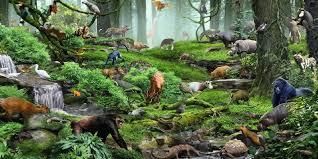
Habitat
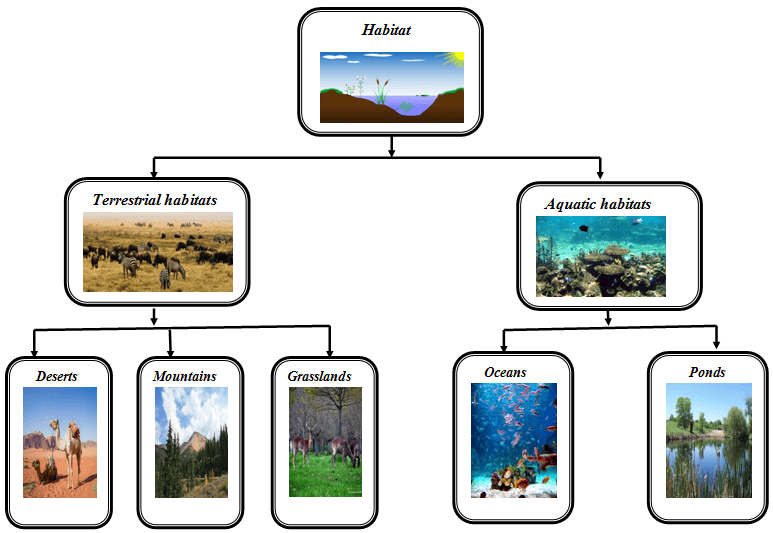
A habitat is like a cozy home for living things in nature. It's where they find their food, water, and everything they need to survive. Each habitat has its own unique characteristics that make it special.
What is a Habitat?
- A habitat is where an animal or plant naturally lives. It's like their own special place in nature.
The Role of Environment in a Habitat
- The environment of a habitat is determined by things like temperature, sunlight, soil type, water availability, and all the different living things there, including people.
- Roads, buildings, and other things people make can also affect a habitat's environment.
How Environment Shapes Life in a Habitat
- The types of living things you find in a habitat depend on its environment.
- For instance, Asiatic wild asses need warm, dry weather, specific plants to eat, lots of space, and not too much water.
- That's why they thrive in places like the warm, sandy deserts of Gujarat.
Different types of Habitats
- There are various types of habitats on Earth, including warm rainforests, cold mountain regions, vast salty oceans, dry sandy deserts, open grasslands, and flowing rivers and lakes. Each habitat has its unique environment, which supports different types of plants and animals. For instance, the plants and animals that thrive in coastal regions are not the same as those found in mountainous areas. Likewise, species that live in cold polar habitats cannot survive in warm forests.
- In our country, there is a diverse range of habitats, such as the cold mountainous Himalayan region, the hot sandy deserts of Rajasthan and Gujarat, the warm coastal areas, dense forests, vast rivers, and the lush green Western Ghats. These varied habitats are home to a rich variety of plant and animal life.
Components of a Habitat
Habitats are made up of living and non-living parts. Living things like plants and animals are part of a habitat, along with non-living elements such as air, soil, water, wind, sunlight, and heat. These components work together for life to thrive in a habitat.
- Living Components: Living components in a habitat are the plants, animals, and other living organisms that reside there. They rely on each other and the non-living components for survival. For example, in a forest habitat, trees, birds, insects, and mammals are all living components.
- Non-Living Components: Non-living components include elements like air, soil, water, wind, sunlight, and heat. These provide the necessary environment for living organisms to exist. For instance, in an aquatic habitat, water is a crucial non-living component that supports fish and aquatic plants.
- Interdependence: Living organisms in a habitat depend on each other as well as on the non-living components. For instance, plants need sunlight for photosynthesis, animals rely on plants for food, and both need water to survive. This interdependence ensures the balance and sustainability of the habitat.
Habitat and Adaptation
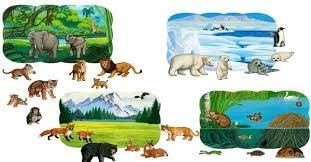
- Adaptations are the physical features and behaviors of a living organism that enable it to thrive in its habitat. Every living thing possesses specific adaptations that help it survive and function effectively in its environment.
- A prime example of adaptation can be observed in the polar bear, which inhabits the cold Arctic region. Let's explore some of the key adaptations that help the polar bear survive in such harsh conditions:
- Insulation: The polar bear's body is covered with a thick layer of hollow hair that traps air, providing insulation against the cold. Additionally, a thick layer of fat beneath its skin further helps to retain body heat. These features ensure that the bear stays warm even when the temperature in the Arctic drops below -30°C during winter.
- Keen Sense of Smell: The polar bear has an extraordinary sense of smell, capable of detecting the scent of a seal from more than 10 kilometers away. This adaptation is crucial for hunting, as it allows the bear to locate and catch seals, which are a primary source of food.
- Energy Conservation: To cope with the extreme conditions of the Arctic, where food is often scarce, the polar bear conserves energy by sleeping for 7-8 hours each day. This behavior reduces its need for food, helping it survive in an environment where resources are limited.
Adaptations of Plants and Animals in Different Habitats
Let's explore the adaptations of plants and animals living in various habitats.
Terrestrial Habitats

Habitats found on land are called terrestrial habitats. Examples include sandy deserts, mountain regions, grasslands, and forests.
Sandy Deserts
A sandy desert is a vast expanse of land covered with sand. It experiences extreme temperatures, becoming hot during the day and cold at night. Deserts are windy places that receive minimal rainfall and have limited water resources. Dew that forms during the cool nights provides a crucial source of water for the plants and animals living there.
Plant Life: Plants that thrive in hot, arid conditions with minimal water and sandy soil are well-suited to sandy deserts. Many thorny plants, known as xerophytes, are adapted to grow in these harsh conditions. Examples include various types of cacti, grasses, aloe, and living stone plants.
Let's examine how desert plants adapt to their environment:
- Scarcity of Rain: In sandy deserts, rain is rare. As a result, the roots of desert plants tend to grow close to the surface and spread over a large area to absorb as much water as possible.
- Small Leaves: Most desert plants have small leaves to reduce water loss through transpiration.
- Spines or Thorns: In many cacti, the leaves have evolved into spines or thorns. The green stem of the cactus carries out photosynthesis and stores water when it rains.
- Protection from Grazing: To prevent being completely eaten by animals, desert plants have spines, such as those found on cacti.
Animal Life: Desert animals, such as camels, mice, desert hares, kangaroo rats, desert foxes, lizards, and snakes, are adapted to survive in hot conditions with very little water. Insects and birds are also common in deserts.
These animals exhibit various adaptations to desert life:
- Water Conservation: Some animals, like kangaroo rats, can survive without drinking water. They extract moisture from the food they eat, mainly plants and seeds.
- Avoiding Heat: Many desert animals avoid the daytime heat by staying in the shade or burrowing underground. They become active in the evening or at night when temperatures drop.
The Camel
The camel is an excellent example of an animal highly adapted to desert life.
- Food and Water Scarcity: Camels can survive for days without food and water. When water is available, they drink large quantities, and when food is abundant, they eat a lot. The excess food is converted into fat and stored in the camel's hump. This stored fat can be broken down into energy when food is scarce.
- Physical Adaptations: Camels have long legs that keep their bodies away from the hot sand. Their toes are joined together to prevent sinking into the sand, and their large padded feet enable them to walk quickly on fine sand.
These adaptations enable both plants and animals to survive and thrive in the challenging environment of sandy deserts.
Mountain Regions
In mountainous areas, temperature decreases as altitude increases. This causes the weather in mountain regions to change with elevation. The lower regions are warmer, while higher altitudes are colder. These environmental differences significantly affect the plants and animals living in these regions.
Plant Life: In the warmer, lower regions of the Himalayas, dense forests of bamboo, oak, and chestnut trees thrive. These plants are adapted to the warmer conditions found at these altitudes.
- As the altitude increases, the temperature drops, and the landscape becomes covered with coniferous forests. Trees like firs, pines, and cedars, which are cone-bearing and evergreen, dominate these higher regions. These trees are adapted to cold conditions. Their pointed and triangular shapes help them shed heavy snow.
- At around 4,000 meters, the weather becomes extremely cold, causing another change in vegetation. Only plants like juniper trees, which are adapted to extremely cold and moist conditions, can survive at such heights.
Animal Life: The number and types of animals found in mountain regions also vary with altitude. Many animals live at the warmer, lower altitudes.
- Animals in the mountains often have thick fur coats to keep them warm. At higher altitudes, where the air is thinner, animals typically have more red blood cells to help them obtain sufficient oxygen.
- Due to the scarcity of plants at colder, higher altitudes, there is less food available for animals. Only a few insects, spiders, and ice worms can survive on the snow-covered peaks of mountains.
Tropical Rainforests
Tropical rainforests are located close to the equator, where the climate is warm and wet throughout the year.
Plant Life: In tropical rainforests, trees never fully shed their leaves. Tall trees grow very close together, with broad leaves and overlapping branches that form a thick, umbrella-like canopy. This canopy blocks nearly all sunlight from reaching the forest floor.
- As a result, only shade-loving plants like ferns, some varieties of palm, and other plants can grow on the wet forest floor. Lichens, orchids, and vines often grow on the trees.
Animal Life: A wide variety of animals inhabit tropical rainforests. Brightly colored butterflies, moths, mosquitoes, termites, ants, and many types of bees and spiders are common. Anteaters and tapirs live on the ground, while animals like leopards, chimpanzees, gorillas, and various snakes alternate between the ground and the trees.
- Birds such as eagles, toucans, and parrots, along with red-eyed frogs, squirrels, various monkeys, gibbons, orangutans, sloths, bats, and many types of snakes, live in the trees.
Grasslands
Grasslands receive rain during the monsoon season, but the rest of the year is dry and hot.
Plant Life: Grasslands are vast, open regions covered with thick growths of various grasses and a few trees.
Animal Life: Grasslands support a rich variety of insects, birds, snakes, lizards, and many types of mammals. Animals in grasslands are adapted to travel great distances in search of water during the dry season.
- Large herbivores like wildebeests, deer, bison, giraffes, and zebras have strong grinding teeth for eating tough grasses. They have long legs and sharp hooves, which allow them to run swiftly away from predators. Their body color and sharp senses also help them escape from threats.
- Carnivores such as lions, wild cats, cheetahs, hyenas, and wild dogs are also found in grasslands. They have strong legs with sharp claws, strong and sharp teeth, and excellent eyesight, all of which help them catch their prey.
Aquatic Habitats
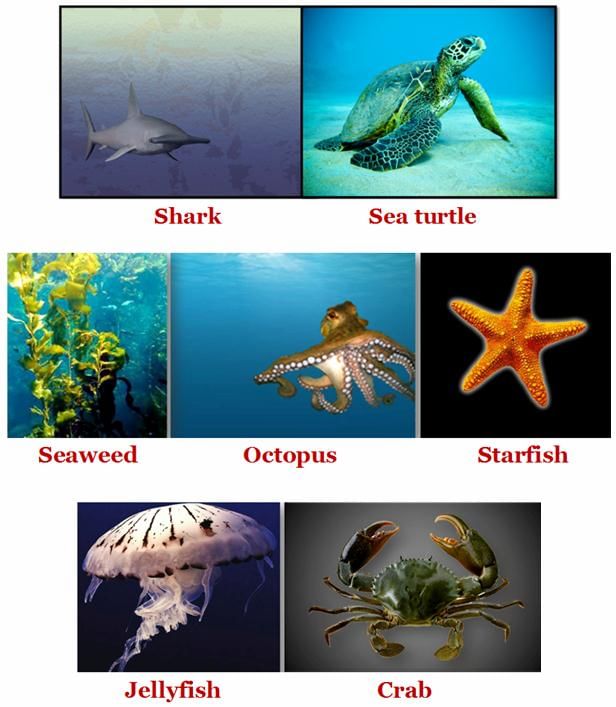
Aquatic regions include bodies of freshwater or saltwater. Freshwater habitats consist of ponds, lakes, rivers, and wetlands, while saltwater habitats include mangrove swamps, coral reefs, seas, and oceans.
Ponds, Lakes, and Rivers:
Plant Life: Plants known as hydrophytes grow in freshwater bodies such as ponds, lakes, and rivers. These plants have adaptations that allow them to thrive in water.
- Some plants, like Hydrilla, grow completely underwater and require less sunlight. Others, like lotus and water hyacinth, grow partly in water and partly above the water's surface. Aquatic plants like duckweed, the smallest known flowering plant, float freely on the water's surface because they need ample sunlight.
- Aquatic plants have air spaces in their stems and leaves, which help them stay erect or afloat. Their large, flat, floating leaves gather enough sunlight, and the waxy coating on the leaves makes them waterproof. Submerged plants often have narrow, ribbon-like leaves that can easily bend with the water's flow. In some cases, the leaves are divided, allowing water to pass through without causing damage.
Animal Life: Freshwater habitats are home to fish, crabs, prawns, frogs, turtles, and crocodiles. Salamanders also live in wet environments.
- Frogs are adapted to live both on land and in water. They breathe air directly from the atmosphere when on land and obtain oxygen from water through their moist skin when submerged.
- Various birds are found near streams, ponds, lakes, and rivers. These birds, known as water birds, obtain food from the water bodies. Many of these birds have webbed feet to help them swim, and their beaks are adapted for feeding on aquatic organisms such as algae, snails, insects, and fish.
Mangrove Swamps
Plant Life: Mangrove swamps, located near tropical seas, are covered with shallow seawater. The soil is silty and covered with salty water. Mangroves help reduce the force of ocean waves and can save lives and property during natural disasters like cyclones and tsunamis.
- Mangrove swamps have a dense growth of mangrove plants. These plants have stilt roots that grow upwards, with their tips remaining above the water's surface to take in air directly from the atmosphere.
Animal Life: Mangrove swamps are home to many marine organisms. Various types of fish and other marine animals use mangrove swamps as feeding and breeding grounds.
Oceans
The oceans cover three-fourths of the Earth's surface and are located in different parts of the planet, each with varying environments. Tropical oceans have warm water, while those closer to the poles have ice-cold water.
Animal Life: Oceans are teeming with a variety of fish, including sharks, tunas, sardines, and mackerels. Their streamlined bodies and fins enable them to swim efficiently, while their gills help them absorb oxygen from water, and their scales protect their bodies.
- Many seabirds, such as seagulls, penguins, terns, puffins, plovers, and pelicans, live on seashores and in the sea.
- Whales, seals, and dolphins are mammals adapted to life in the oceans. They have flippers and streamlined bodies that help them swim. A thick layer of fat, called blubber, keeps them warm and buoyant in the water. Although they live in the ocean, these mammals breathe air directly from the atmosphere. Sea snakes and sea turtles are reptiles that inhabit the oceans.
- Some ocean animals, like corals, sea anemones, and crabs, live in the low-tide regions of the sea. They are adapted to live in shallow water exposed to air and sunlight. Unlike fish, these sea animals can survive even when not fully submerged in water.
Acclimatization
Acclimatization is the process where living things adjust to their environment over a short period of time. Imagine going from a warm place to a very cold place during your holiday. At first, it's hard to handle the sudden change, but after a few days, your body gets used to the cold. This ability to quickly adapt to new surroundings is called acclimatization.
- Living things change quickly to fit in:
- When you move from a warm place to a cold place, your body has to adjust fast.
- Initially, the cold might feel too much, but after some days, it becomes easier.
- Example with a holiday trip:
- Imagine you go on vacation to a place much colder than where you live.
- Initially, the cold feels harsh on your body because it's not used to it.
- After a few days, your body starts getting used to the cold weather.
- Adjusting to new environments:
- Acclimatization is like your body quickly adapting to a new place.
- It's about making small changes in a short time to live comfortably in a new environment.
Characteristics of Living Things
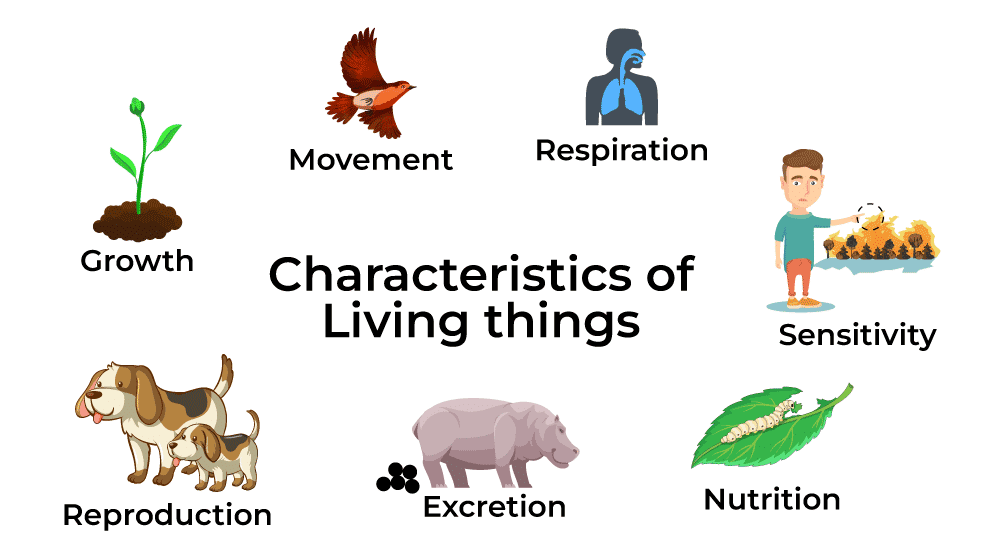
The Earth hosts a vast variety of life forms, including plants, animals, fungi, and microorganisms. Despite their differences and diverse habitats, all living things share certain common characteristics.
Growth
- Growth is a fundamental characteristic of all living organisms. It is often observed as an increase in height or length.
- Animals grow when they are young and generally stop growing after reaching a certain age. In contrast, plants continue to grow throughout their entire lives.
Food and Water
- All living organisms require food to survive. Autotrophs are organisms that can make their own food, primarily through the process of photosynthesis. Most plants fall into this category, as do some microorganisms. However, some plants, like Cuscuta, are total parasites and rely on other plants for food and water because they cannot produce their own.
- On the other hand, heterotrophs are organisms that depend on other living things for their food. All animals are heterotrophs. Additionally, water is essential for all living organisms, and they obtain it from their surroundings.
Movement
- Movement is another characteristic of living things. Most animals are capable of moving from one place to another. While plants do not move from their location, they can move parts of their bodies.
- For example, plant shoots grow towards light, and some plants close their leaves at night and reopen them in the morning.
Respiration
- Respiration is the process through which living organisms obtain energy from their food. This process includes both breathing and the release of energy. Most living things require oxygen for respiration, which they obtain through breathing. This process also involves the removal of carbon dioxide from the body.
- Plants take in air through tiny openings called stomata. Human beings, land-dwelling animals, and some aquatic animals, such as turtles, sea snakes, whales, and dolphins, breathe air and use oxygen for respiration. Fish and many other aquatic animals, however, take in oxygen dissolved in water. Although turtles and sea snakes live in water, they still breathe air like land animals.
Response to Stimuli
- All living organisms respond to stimuli, which are external factors that cause a reaction. For instance, sunlight is a stimulus that causes plant shoots to grow towards it.
- Similarly, certain sounds can alert a grazing deer, prompting it to run away. The smell of certain foods can stimulate hunger in humans.
Excretion
- Excretion is the process by which living organisms eliminate waste products from their bodies.
- In animals, excretory organs, such as the kidneys in humans, are responsible for removing these waste products.
Reproduction
- Reproduction is the process by which living organisms produce offspring similar to themselves. Different species have different methods of reproduction. Many animals lay eggs, from which their young hatch. Mammals, including humans, give birth to live young, and the mother feeds her babies with milk.
- Plants also reproduce, and they can be broadly classified into flowering and non-flowering plants. Flowering plants produce flowers that develop into fruits containing seeds. These seeds, when provided with the right conditions—such as warmth, water, and air—germinate and grow into new plants.
- Non-flowering plants, such as pine trees, ferns, and mosses, reproduce through different means. Pine trees produce cones that contain seeds, while ferns and mosses produce spores, which give rise to new plants.
Lifespan
- All living organisms have a lifespan, which is the duration of time they live before they die. This varies greatly among species.
- For example, some insects like the mayfly live only for a few days, while some tortoises can live for over a hundred years. Trees typically live for many years, whereas herbs may only survive for a few months.
|
44 videos|157 docs|54 tests
|
FAQs on Living Organisms and Their Surroundings Chapter Notes - Basic Science for JSS 2
| 1. What are the different types of habitats? |  |
| 2. How do plants and animals adapt to their habitats? |  |
| 3. What are the components of a habitat? |  |
| 4. What is acclimatization in relation to habitats? |  |
| 5. How do living things show characteristics of adaptation in different habitats? |  |





















